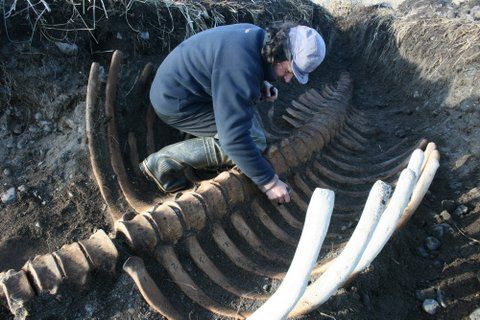
A 17-foot skeleton buried beneath the sand and stone of Russia's far eastern coastline has been dug up and identified as the remains of an extinct sea mammal, the nature ministry announced on Friday.
During a regular survey of a nature reserve on the tiny Commander Islands in Russia's Kamchatka region, local officials spotted what looked like a "fence" of bones poking from a patch of the beach where the sand had cleared.
Buried only a couple of feet beneath was a mass of 45 vertebrae, 27 ribs, a left scapula and other bones. After a four-hour dig with the help of eight people, the massive skeleton was excavated and identified, the Ministry of Natural Resources and Ecology said in a statement.
The sea creature's skull and several other important bones were missing, but scientists were able to identify the creature as a Steller's sea cow—an extinct sea mammal that could grow to 30 feet. The species dates from the Pleistocene epoch, which began 2.6 million years ago and ended 11,700 years ago.
Scientists have not yet determined the age of the specimen but have been able to establish other facts about the beast. Assuming it had an average sized skull, it is likely that the animal stretched to 20 feet in length.
The reserve posted photographs of the excavation on its official website and noted that the skeleton will now to go on show in its local visitor's center.
The species died out in the late 18th century, within decades of its discovery by Arctic explorers. Today only its smaller relatives such as the dugong and the manatee survive. It bears the name of the German explorer, Georg W. Steller, who first documented the creature's existence during a voyage through the North Pacific in 1741, according to the Encyclopaedia Brittanica.
Even by the time of Steller's discovery, the ancient sea mammal's numbers in the isolated waters between mainland Russia and Alaska were dwindling. Around 2,000 were believed to exist at the time of their discovery, but they were n easy target for harpoon hunters and had been exterminated by 1768.
The large size of the animal, weighing up to 10 metric tonnes (more than 22,000 pounds), allowed it to survive in its chilly environment but also made it slow to escape attackers on land.
The previous reported finding of any fragments from a Steller's sea cow happened in 1987, on the same island, as the latest discovery by Russian scientists.
Uncommon Knowledge
Newsweek is committed to challenging conventional wisdom and finding connections in the search for common ground.
Newsweek is committed to challenging conventional wisdom and finding connections in the search for common ground.
About the writer
I am a Staff Writer for Newsweek's international desk. I report on current events in Russia, the former Soviet Union ... Read more
To read how Newsweek uses AI as a newsroom tool, Click here.








